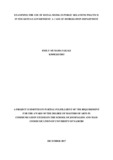| dc.contributor.author | Sakali, Emily M | |
| dc.date.accessioned | 2018-01-30T05:28:42Z | |
| dc.date.available | 2018-01-30T05:28:42Z | |
| dc.date.issued | 2017 | |
| dc.identifier.uri | http://hdl.handle.net/11295/102867 | |
| dc.description.abstract | The purpose of this study was to examine the use of social media in public relations practice in the Kenyan government, a case of Immigration Department. To achieve this, its objectives were; to analyze the modes of social media platforms embraced by public relations officers at Immigration Department; to assess whether social media use has enhanced achievement of public relations practice objectives in Immigration Department; to determine factors for preference of social media tools employed in public relations practice in the Immigration Department. The research was anchored on two theories; social presence and media richness. The research design was descriptive survey, which took a mixed approach employing both qualitative and qualitative approaches. The research method was a case study survey. Data was collected using questionnaires and interview. The target population was immigration officers and public relations officers in the Immigration Department. Simple random sampling was used to select 180 immigration officers with a corresponding response rate of 165 (77.8%). There was a definite focus to choose 10 public relations officers for another questionnaire and interview, with a corresponding response rate of seven (70%) for a questionnaire and four (40%) for interview. The findings indicated that social media is used in public relations practice in Immigration Department but with partial use in relation to internal communication. Facebook and Twitter are the most preferred tools for external publics, mainly because of ease, reach and speed in use. WhatsApp was preferred for internal publics mainly as an alternative to traditional media. These social media tools are used mainly for informational updates and response to enquiries. Respondents were in a unanimous agreement that social media has improved service delivery at the department. Interviewees indicated that there was a risk averse culture that restricts free social media use in Immigration Department. The study concluded that social media is rich in meeting communicative and service objectives in public relations practice in government, but there was lack of right approach to implement it. The study recommends the following. Development of a harmonized media strategy, offer training to officers and embrace social media tools appropriate for internal publics with a bit of friendliness. | en_US |
| dc.language.iso | en | en_US |
| dc.publisher | University of Nairobi | en_US |
| dc.rights | Attribution-NonCommercial-NoDerivs 3.0 United States | * |
| dc.rights.uri | http://creativecommons.org/licenses/by-nc-nd/3.0/us/ | * |
| dc.subject | Examining the Use of Social Media in Public Relations Practice in the Kenyan Government: a Case of Immigration Department | en_US |
| dc.title | Examining the Use of Social Media in Public Relations Practice in the Kenyan Government: a Case of Immigration Department | en_US |
| dc.type | Thesis | en_US |



